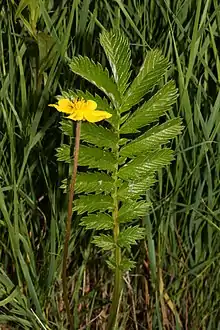Argentina anserina
Argentina anserina (synonym Potentilla anserina) is a perennial flowering plant in the rose family, Rosaceae. It is known by the common names silverweed, common silverweed or silver cinquefoil. It is native throughout the temperate Northern Hemisphere, often on river shores and in grassy habitats such as meadows and road-sides. The plant was originally placed in the genus Potentilla by Carl Linnaeus in his Species plantarum, edition 1, (1753) but was reclassified into the resurrected genus Argentina by research conducted in the 1990s.[2] The reclassification remains controversial and is not accepted by some authorities.[1][3][4][5] It is a species aggregate which has frequently been divided into multiple species.[6][7]
| Argentina anserina | |
|---|---|
 | |
| Scientific classification | |
| Kingdom: | Plantae |
| Clade: | Tracheophytes |
| Clade: | Angiosperms |
| Clade: | Eudicots |
| Clade: | Rosids |
| Order: | Rosales |
| Family: | Rosaceae |
| Genus: | Argentina |
| Species: | A. anserina |
| Binomial name | |
| Argentina anserina | |
| Synonyms[1] | |
| |
Description

Silverweed is a low-growing herbaceous plant with creeping red stolons that can be up to 80 cm long. The leaves are 10–20 cm long, evenly pinnate into in saw-toothed leaflets 2–5 cm long and 1–2 cm broad, covered with silky white hairs, particularly on the underside. These hairs are also present on the stem and the stolons. These give the leaves the silvery appearance from which the plant gets its name.
The flowers are produced singly on 5–15 cm long stems, 1.5-2.5 cm diameter with five (rarely up to seven) yellow petals. The fruit is a cluster of dry achenes.
Habitat
Silverweed is most often found in sandy or gravelly soils, where it may spread rapidly by its prolific rooting stolons. It typically occurs in inland habitats, unlike A. egedii, which is a salt-tolerant coastal salt marsh plant.
Cultivation and uses
The plant was put in shoes to absorb sweat. It was formerly believed to be useful for epilepsy, and that it could ward off witches and evil spirits.[8]
The plant's roots were eaten by some Native American tribes.[9] It has been cultivated as a food crop for its edible roots, which resemble parsnips.[10] It may also become a problem weed in gardens.
Travelers visiting Tibet reported on the food use of the plant's root in the region. According to Pyotr Kozlov, who traveled in the Kham region in 1900–1901, Tibetans, who did not have any vegetables other than turnips, would often dig out roots of Argentina anserina (whose local name he gave as djüma), which could be easily dried and stored for later use. Kozlov even suggested that it would not be a bad idea for Russian peasants to do likewise, especially in famine years.[11] The mission of Sarat Chandra Das to Tibet in the late nineteenth century reported that the root of the plant, under a Tibetan name variously transcribed as toma, doma or droma, was served cooked in butter and sugar at the New Year's celebrations in the Tibetan capital Lhasa.[12]
Etymology and folklore
The pre-Linnaean name anserina means "of the goose" (Anser), either because the plant was used to feed them or because the leaves reminded of the bird's footmarks. In Sweden, the flower is called gåsört (goose-wort).
A rich folklore has developed around Silverweed. The plant bears the common name of richette in French, being rich through both silver and gold.
There is a legend that the Christ Child grew up and walked the roads of Palestine; and the yellow flowering plant of the dusty wayside with silvery fern-like leaves that lay flat on the ground has been called the Footsteps of Our Lord.[13]
Fossil record
Argentina anserina achenes are rather rare in Pliocene fossil floras of the East Europe but common in the Pleistocene.[14]
References
- "The Plant List: Potentilla anserina L." Royal Botanic Gardens, Kew and Missouri Botanic Garden. 2013. Retrieved 19 May 2016.
- A key to the Potentilla complex
- "Tropicos.org". Retrieved 3 February 2015.
- "Online Atlas of the British and Irish Flora: Potentilla anserina L." Retrieved 27 May 2016.
- Stace, Clive (2019). New flora of the British Isles (4th ed.). Suffolk, UK: C&M Floristics. ISBN 978-1-5272-2630-2.
- Arne Rousi (1965). "Biosystematic studies on the species aggregate Potentilla anserina L.". Annales Botanici Fennici. 2 (1): 47–112. JSTOR 23724290.
- Koski, M.H.; Ashman, T.-L. (2013). "Quantitative Variation, Heritability, and Trait Correlations for Ultraviolet Floral Traits in Argentina anserina (Rosaceae): Implications for Floral Evolution". International Journal of Plant Sciences. 174 (8): 1109–1120. doi:10.1086/671803. S2CID 85308493.
- Howard, Michael. Traditional Folk Remedies (Century, 1987), p.121
- Fagan, Damian (2019). Wildflowers of Oregon: A Field Guide to Over 400 Wildflowers, Trees, and Shrubs of the Coast, Cascades, and High Desert. Guilford, CT: FalconGuides. p. 138. ISBN 978-1-4930-3633-2. OCLC 1073035766.
- Niering, William A.; Olmstead, Nancy C. (1985) [1979]. The Audubon Society Field Guide to North American Wildflowers, Eastern Region. Knopf. p. 752. ISBN 0-394-50432-1.
- P.K.Kozlov, "Монголия и Кам. Трехлетнее путешествие по Монголии и Тибету (1899--1901 гг.) (Mongolia and Kham. Three years' travel in Mongolia and Tibet (1899-1901). Kozlov gives the plant's Latin name as Potentilla anserina, and transcribes its Tibetan name in Russian as джюма (dzhyuma). (in Russian)
- https://archive.org/stream/journeytolhasace00dass/journeytolhasace00dass_djvu.txt
- Taylor, Gladys. Saints and their Flowers. London, England: A. R. Mowbray & Co., Oxford,1956.
- The Pliocene flora of Kholmech, south-eastern Belarus and its correlation with other Pliocene floras of Europe by Felix Yu. VELICHKEVICH and Ewa ZASTAWNIAK - Acta Palaeobot. 43(2): 137–259, 2003
| Wikimedia Commons has media related to Potentilla anserina. |
- Lamoureux, G.; et al. (1983). Plante sauvage des villes, desa champs et en bordure des chemins. Fleurbec. ISBN 2-920174-07-X.